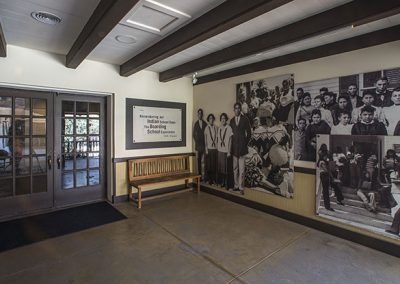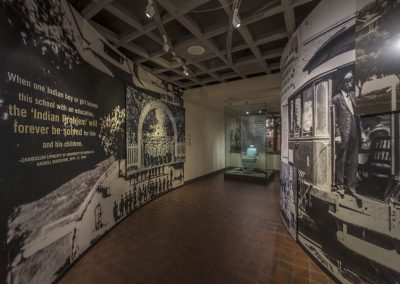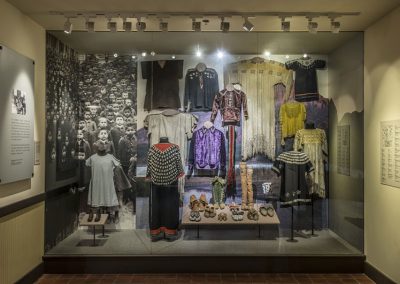The History of the Original Exhibition
Many guests are not aware of and surprised to learn about this history. Originally envisioned as a five-year installation, the “boarding school exhibit,” as it has become known, was of strong interest for both Native and non-Native audiences and the Heard Museum kept it open year after year.
Beginning in 1995, major support was provided by the National Endowment for the Humanities (NEH). Initial planning and research for the boarding school exhibition was begun by Curator of Fine Art Margaret Archuleta (Pueblo/Hispanic). She formed an advisory group, including Brenda Child (Red Lake Ojibwe, University of Minnesota), Rayna Green (Cherokee, National Museum of American History, Smithsonian Institution), K. Tsianina Lomawaima (Mvskoke/Creek Nation, unenrolled, University of Arizona) and Karen Gayton Swisher (Standing Rock Sioux, Haskell Indian Nations University)*
Curator Margaret Archuleta identified relevant objects that would assist in telling the boarding school story. She found 19 institutions and 10 individuals willing to loan art and artifacts. Other planning components included visits to archival repositories for research and images to tell the story. An oral history contractor, Tessie Naranjo (Santa Clara Pueblo) was hired to collect 53 oral histories.
Plans were also implemented to generate a museum-produced publication, Away From Home: American Indian Boarding School Experiences, 1879 – 2000. The advisory committee and other invited scholars wrote articles which, along with object images, archival images, prose and poetry by Native authors, contributed to the catalogue. Another publication was assembled, again drawing on scholarly articles, to produce a special issue of the Journal of American Indian Education, 1996, Special Issue, vol. 35 (3).
The exhibition team fabricated a 4,000-square-foot multi-sensory gallery. Remembering Our Indian School Days: The Boarding School Experience opened in November 2000. Many alumni and research participants attended the opening event, made even more special with a reading from The Indolent Boys by Pulitzer Prize-winning Kiowa novelist, poet and artist N. Scott Momaday.
The original exhibition drew on first-person recollections, memorabilia and the writings and art of four generations of Indian school alumni to examine the commonality of the boarding school experience. Exploring an important and untold era of American history, the exhibition incorporated historic images, music, sound, oral histories, memorabilia and video to immerse visitors in the story being told by the people who lived it.
The exhibition was comprised of 10 sections constructed to emulate different boarding school experiences and environments, from the first arrival of students to classrooms and dorm rooms.
Moving Forward
In 2015, Janet Cantley, Curator, was awarded a planning grant by the NEH. It allowed the Heard Museum to revisit and revise the exhibition content based on new scholarship and recommendations from an advisory team composed of Brenda Child (University of Minnesota), K. Tsianina Lomawaima (Arizona State University), Jon Reyhner (Northern Arizona University), Charles “Monty” Roessel (Diné, Bureau of Indian Education; president of Diné College) and Patricia Talahongva (Hopi filmmaker and journalist, Phoenix Indian School alumna and curator for the Phoenix Indian School Visitor Center)*. At planning meetings the advisory committee and Heard team felt much of the original exhibit’s content remains relevant and continues to offer a profound and powerful visitor experience.
The combination of a generous gift from a private patron of the arts and a NEH Implementation Grant awarded in May 2017 enabled expansion of the immersive experience, presenting new digital technologies, new art and new archival collections to Heard audiences. The advisory team for the implementation phase includes the 2015 planning group and Matthew Sakiestewa Gilbert (Hopi, University of Illinois, Urbana-Champaign).* Visitor exit surveys, tracking surveys, admission reports, and docent accounts all document that the boarding school exhibition is a powerful story, the most sought out by visitors, and a revelation to many who are unaware of this part of our shared history.
Funding in the implementation phase allowed the Heard to collect more stories in filmed interviews, including alumni, teachers, administrators, and advisory committee members. The Heard and advisory team responded to the need and desire expressed by so many to take the exhibition further into the current era—to answer the demand by and to honor those who lived the boarding school experience, who are still living it, or by those who simply want to know more.
Development of new digital technologies provide in-depth exploration of the history of American Indian boarding schools. Digital timelines present government policies and milestones in American Indian education, as well as personal stories of Indian School alumni who led advocacy efforts in reforming the schools, and improving conditions and civil rights for American Indians, in general. An interactive map allows visitors to explore profiles of selected schools with histories covering several generations of students.
With the exhibition in place for almost two decades, an awareness of the Heard Museum’s commitment to the topic has been recognized. Since the opening of Remembering Our Indian School Days, the museum has received around twenty donations to the art and another twenty acquisitions to the archive collections. It is very gratifying to receive a Letterman’s jacket from a Haskell alumnus, who wanted the Heard as a repository for his cross-country jacket. A basket that was gifted to a family in rural Pennsylvania by a Carlisle Indian School student in 1904, sent us on an exciting journey of exploring one Inupiat student’s life at Carlisle, and after, by examining digitized student records at Dickinson College (Carlisle Indian School Digital Resource Center).
The re-opening as Away From Home: American Indian Boarding School Stories was a celebratory and honoring event. Several hundred community members came to a special evening of ribbon-cutting, prayer and blessing and welcoming by the director of the Heard and staff. A panel comprised of our advisory committee and additional partners discussed topics on American Indian education to a full auditorium on opening day.
With the development of the Heard microsite and a traveling exhibition sponsored by NEH On the Road, we will be reaching new audiences. Our mission to honor the many generations of American Indian boarding school students is reaching further than anticipated with the opening of a “short term” exhibition two decades ago.
“Arrival” Section with a case housing traditional clothing that would have been replaced by uniforms in original exhibition
Bank of American
Mr. and Mrs. William Freeman
Intel Corporation
National Endowment for the Humanities
Rockefeller Foundation
The Arizona Republic
Fred and Ann Lynn
Roger S. Firestone Foundation



